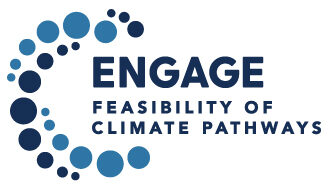ENGAGE Summary for Policymakers
As the world faces the risks of dangerous climate change, policymakers, industry and civil society
leaders are counting on Integrated Assessment Models (IAMs) to inform and guide strategies to deliver
on the objectives of the Paris Agreement (PA) and subsequent agreements. ENGAGE has responded to
this challenge by engaging these stakeholders (see Section 9) in co-producing a new generation of
global and national decarbonization pathways (Sections 5 and 6). Tools and approaches have been
developed to explore the multidimensional feasibility of these decarbonization pathways (Section 3) and
identify opportunities to strengthen climate policies by minimizing feasibility risks. New emission
pathways have been designed to minimize overshoot of the temperature target (Section 4), explore
the timing of net-zero emissions to meet the Paris temperature target, and reduce the reliance on
controversial negative emissions technologies. However, global decarbonization pathways are only
feasible in as much as they are aligned with national policies and plans, so the project has paid
particular attention to aligning and reconciling global decarbonization pathways with national emission
reduction policies and pledges and international governance mechanisms (Sections 5 and 6). The
project has also quantified avoided impacts of climate change, co-benefits, and trade-offs of climate
policy (Section 8) and explored the effort-sharing implications of decarbonization pathways (Section 7).
The results summarized in the following sections could only be achieved with multi-, inter- and
trans-disciplinary expertise. The project team brought together a global consortium of leading IAM
teams from Europe and non-EU countries (Brazil, China, India, Indonesia, Japan, Korea, Mexico,
Russia, Thailand, the USA, and Vietnam). In total 74% of global CO2 emissions in 2015 were
originating from countries represented in the consortium (incl. external partners), including 9 of the
11 largest emitters. The countries range between high-income countries (e.g., EU, Japan, USA) and
lower middle-income countries (India, Vietnam). The ensemble of Integrated Assessment Models that
has been used covers a wide range of approaches. The variety of different model types helped
identify robust insights that hold across different models.

